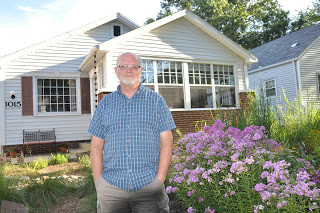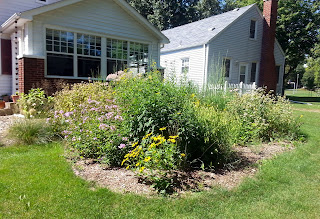The first thing I noticed when walking toward Bob and Nancy Larson’s house is the beautifully manicured centerpiece in his perfectly trimmed lawn. It’s hard to miss. The tall plants grab your attention long enough to realize that not everything is green. A closer look and little spots of color start to stand out. There is purple from the Joe Pye Weeds, yellow from the black-eyed Susan and light blue from the wild prairie petunias. The garden shines.
But this garden is more than a centerpiece. It is a tool.
When the Larson’s moved into their Champaign, Ill. home in 2009, they were excited to settle into their new neighborhood. However, just three days after they moved in, their basement flooded from the sanitary sewer backing up. It was then when Larson was made aware of the stormwater issues in his neighborhood. It also did not help that 2009 was the fifth wettest year on record since 1889. Seeing how having a flooded basement could become a continuous problem in the future, he decided to research ways he could prevent the buildup of water. That was when he discovered rain gardens. In conducting his research he became more and more interested in installing one of his own.
With the help of The Blue Thumb Guide, he started to design his own garden. He drew inspiration from designs he found in other books, online, and from visiting other gardens. When it was time to pick plants to place in his garden, he was drawn to native plants and made a conscious effort to seek those out. He visited nurseries to find the best plants for his garden, as well as using the book Native Plants in the Home Landscape for the Upper Midwest to organize his choices.
When it came time to start digging in his yard, Larson was optimistic, that is until he discovered there were layers of rocks under his soil. Even though this was an inconvenience for him, he patiently relocated the rocks and continued to carefully dig.
He placed the garden in the center of his front yard, to draw water away from his home. Blooming flowers on the outer part of the garden act almost as a lining. When in full bloom, there are many colors jumping out–they are very pronounced against the white of his house and really do act as a centerpiece in his lawn. In the center of the garden are plants with thicker stems as well as grass-like plants, such as purple coneflowers, sideoats grama, little bluestem, and big bluestem. This creates a very full yet manicured garden, yet the chaos that could happen with such a large array plants is contained.
Larson advises people to not over plant their garden as it can become more difficult to maintain a clean look, if that is what they want. He also stresses the importance of knowing the soil type. He has very fertile soil that drains well, so he chose not to add sand.
“I think it would have helped if I would have added sand to cut down on the fertility so stuff wouldn’t grow so big,” he said. “It’s kind of hard to do that afterwards.”
When installing a rain garden it is important to know what kind of garden your want, so even if you choose to do it on your own like Larson, it is still very manageable and attainable.
-Victoria Figueroa



